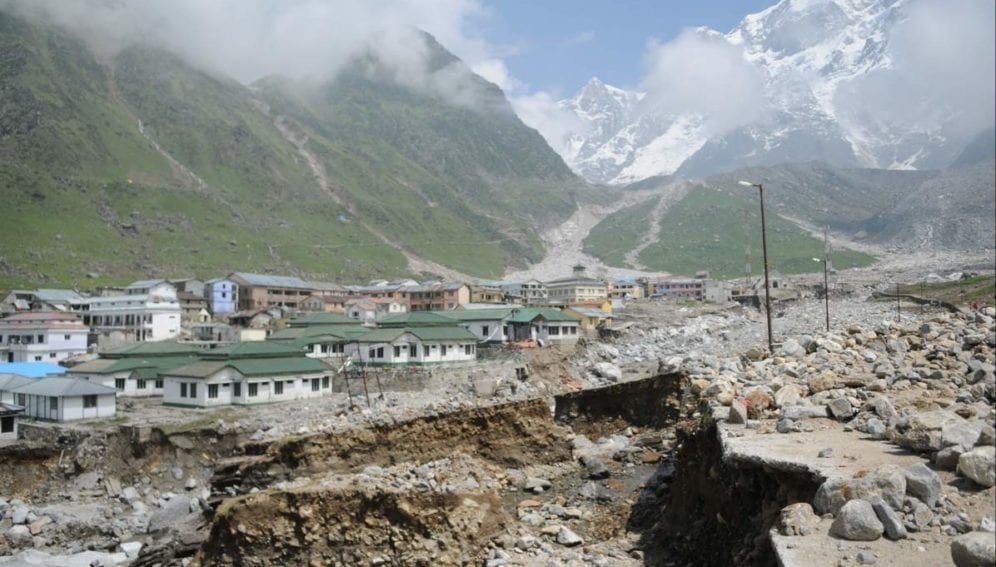By: T.V. Padma
Send to a friend
The details you provide on this page will not be used to send unsolicited email, and will not be sold to a 3rd party. See privacy policy.
The large-scale devastation and deaths caused by landslides and floods in the northern Himalayan state of Uttarakhand have highlighted gaps in India's disaster preparedness, as well as a worrying neglect of environmental concerns in hilly areas.
Scientists say a lake at the snout of the Chorabari Glacier was almost brimming over with glacial meltwater before the floods on 16 June. Then, India's increasingly unpredictable and erratic monsoon set in a fortnight early.
Incessant rains aggravated by a cloudburst triggered a torrent, which in turn breached a local natural dam. The deluge that followed washed away people, fragile rocks and soil, buildings and even entire villages.
The floods left more than 1,000 dead and several thousand missing or homeless, and wiped out villages, roads and buildings. Uttarakhand is home to several popular hill resorts as well as the ancient Hindu temple of Kedarnath, which attracts thousands of pilgrims each year during summer.
"The Uttarakhand floods have taken everyone by surprise," Aslam Perwaiz, head of disaster risk management systems at the Asian Disaster Preparedness Centre, based in Thailand, tells SciDev.Net.
Disaster unpreparedness
The centre works with government agencies in other countries, but does not provide any early warning to the Indian government. Instead its work is limited to increasing the capacity of India's National Disaster Management Authority (NDMA) to respond to emergencies.
Perwaiz says the gaps in disaster management are not fully known in this case, but "certainly, there is a disconnect between early warning generation and dissemination. We will hear more as we go through the recovery and reconstruction phase." He also stresses the importance of investing in disaster preparedness based on scientific tools.
The Himalayas are geologically the youngest mountain range in the world and the Indian geological plate is moving northwards by five centimetres each year, hitting and sliding under the Eurasian tectonic plate and making the mountain ranges prone to landslides and earthquakes.
C. P. Rajendran, Ramanujam fellow at the Centre for Earth Sciences of the Indian Institute of Science, tells SciDev.Net that landslides and floods are not new to the area. What made this set of floods so devastating, he says, was the high density of tourists and an unprecedented boom in construction in high-risk flood-plains such as river valleys.
The Indian Meteorological Department says it did forecast heavy showers in the state, but local authorities did not seem to anticipate the potential damage. The Indian Space Research Organisation and the NDMA are at loggerheads, with ISRO asserting that it used to satellite images to provided adequate warning of the rains; and the NDMA saying there was no such warning.
The rush to develop
The unseasonal downpour on 16 June is yet another indicator of changing monsoon patterns in India, which climate scientists have been predicting. In 2010 scientists at the Indian Institute of Tropical Meterology reported that extreme weather events in India would become more intense due to climate change.
Agriculture in much of South Asia depends on the monsoon rains, so researchers have focused on the impact of climate change on the Asian monsoon. In June 2012 an international team of scientists reported in Nature Climate Change that global warming would make understanding changes in the Indian monsoon more difficult.
Several nongovernmental organisations (NGOs) working on environmental issues have, however, pointed out more endemic problems than timely weather warning or climate change models. They say the state government ignored environmental concerns in its rush to establish hydropower projects and encourage unsustainable tourism in the area.
“It is also a fact that changing monsoon patterns will require us to optimise use of every drop and not allow rain to become devastating flood.”
Sunita Narain
A federal audit report of Uttarakhand state, released in 2013, also warns that the state government was "indiscriminately" pursuing hydropower projects, with potentially damaging effects. According to the report, 42 projects are operating and a further 203 are under clearance or construction.
The state disaster management authority has not met since being formed in 2007, it says. Debris generated from excavation and construction activities was openly dumped into the rivers, and the construction of plants posed "severe hazards both for natural ecology and stabilisation of the slopes".
The projects did not have specific measures to cope with the risk of flash floods, according to the report. For example, it is necessary to plant trees in the cleared areas around hydropower plants to avoid soil erosion and provide structural stabilisation in landslide-prone areas, but there was no evidence of this happening.
Poor oversight
In June this year, the South Asia Network on Dams, Rivers and People, an NGO, said in a report that the approval committee on river valley projects of the Indian Ministry of Environment and Forests had approved all river valley projects between 2007 and 2012, and had failed to assess the cumulative impact of "bumper to bumper hydropower projects" on several rivers.
The report also criticised an Indian Interministerial Group committee report on 60 hydropower projects in the Upper Ganges basin, which it says is heavily biased in favour of large hydropower projects and ignores local opposition to some projects.
The report says the group has "poor understanding of the science of the rivers", and has reservations about IMG calculations of the length of the river that is affected by the hydropower projects and the distance and gradients between projects which affect river flow.
The IMG has also reached the erroneous conclusion that there is no need to flush the rivers of silt deposits during the monsoon time, says SANDRP. All the projects depend on regular river flow and have few or no storage dams, meaning flushing is necessary, according to the NGO.
An editorial by Sunita Narain, director of India's Centre for Science and Environment, points out: "It cannot be anybody's contention that the Himalayan region must not see development. The question to consider is how it should develop: by building roads and hydropower projects or local economies based on tourism, which do not work against nature.
"It is also a fact that changing monsoon patterns will require us to optimise use of every drop and not allow rain to become devastating flood. Only then will the Himalayan tragedy not be repeated."














